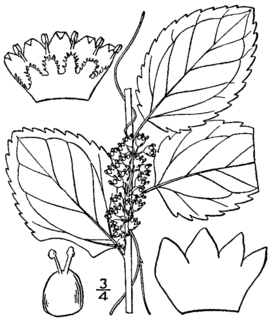Stigmatomycosis is a fungal disease that occurs in a number of crops, such as cotton, soybean, pecan, pomegranate, citrus, and pistachio. It has been reported on pistachio in Greece, Iran, Russia, and is frequently a problem in California pistachio orchards severely infested by hemipteran insects. In a 1989 survey in California, fruit with stigmatomycosis were found in 90% of samples collected from late June to mid-September and from all growing areas.
Eremothecium coryli is a plant pathogen that causes stigmatomycosis.
Mamianiella coryli is a plant pathogen.
Monostichella coryli is a plant pathogen infecting hazelnuts.

Colocasia coryli is a moth of the family Noctuidae. It is found in Europe. Western Asia. In the North, the distribution area includes northern Scandinavia, in the South the moth is limited to montane areas of Western and Northern Spain, Sicily, Greece and Asia minor. In the East the range extends across the Palearctic to Lake Baikal. In the Alps coryli rises up to 1600 m. asl.
Kampimodromus aberrans is a species of mite in the family Phytoseiidae. It is found in Europe.
Kampimodromus adrianae is a species of mite in the family Phytoseiidae.
Kampimodromus alettae is a species of mite in the family Phytoseiidae.
Kampimodromus echii is a species of mite in the family Phytoseiidae.
Kampimodromus ericinus is a species of mite in the family Phytoseiidae.
Kampimodromus hmiminai is a species of mite in the family Phytoseiidae.
Kampimodromus keae is a species of mite in the family Phytoseiidae.
Kampimodromus langei is a species of mite in the family Phytoseiidae. It is found in Europe.
Kampimodromus ragusai is a species of mite in the family Phytoseiidae.

Phyllonorycter coryli, or nut leaf blister moth, is a moth of the family Gracillariidae. It is found most of Europe, except the Balkan Peninsula.

Apoderus coryli, common name hazel-leaf roller weevil, is a species of leaf-rolling beetles belonging to the family Attelabidae subfamily Attelabinae. Because of the trunk-like elongated head, it is often mistakenly attributed to the weevils.

Phylus coryli is a species of plant bugs belonging to the family Miridae, subfamily Mirinae. The species is widespread in Europe including the British Isles, but missing in parts of the southern Mediterranean. To the East is found in the Caucasus. It is introduced in North America.It feeds on Corylus avellana. The species is 4.5–5.5 millimetres (0.18–0.22 in) long and is light brown to black coloured while its cuneus is reddish.
Corythucha coryli, the hazelnut lace bug, is a species of lace bug in the family Tingidae. It is found in North America.

Monocesta coryli, the larger elm leaf beetle, is a species of skeletonizing leaf beetle in the family Chrysomelidae. It is found in eastern and southeastern North America, from Florida west to Kansas and north to Pennsylvania. It is the only species of the large neotropical genus Monocesta known to be found in the United States. Its specific epithet refers to its feeding on hazels, though it feeds and lives primarily on elms. Adults are easily identified by their relatively large size and orange coloration with metallic blue-green spots, though they may also have brown spots or no spots.

Cuscuta coryli, synonym Grammica coryli, common name hazel dodder, is a perennial plant in the Cuscutaceae family native to North America.




